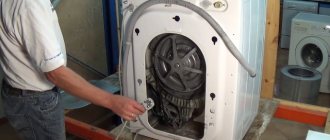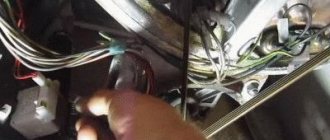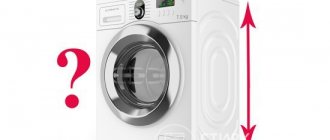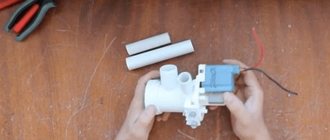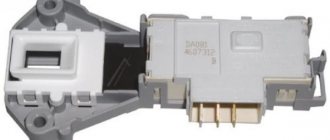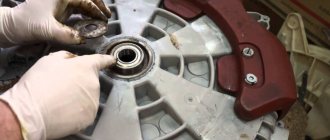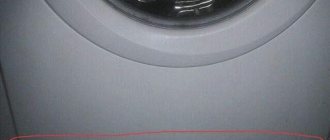How to identify the exact nature of the breakdown?
Washing equipment sometimes breaks down and becomes unusable for many reasons. If, during the washing and rinsing process, extraneous noise occurs, which is additionally accompanied by vibration, it can be assumed that the shock absorbers and parts of the part have crumbled or failed. However, the same symptoms can also be observed if the bearings in the washing machine have crumbled, or foreign objects have entered the space between the laundry tub and the body. To make sure that the shock absorbers are broken, you should first disconnect the washing machine from the network. After this, you need to open the doors to load laundry, then slightly pull the device towards you and release. If it falls into place without difficulty and extraneous noise, then the dampers are working. The washing machine swaying from side to side will be evidence that the springs have failed.
How to replace?
Installation of new shock absorbers is carried out according to the following algorithm:
- We place the new element in place of the removed part, in special grooves.
- Carefully screw in the “nail” fastener and remove the self-tapping screw from it.
- Turning the washing machine over to the other side, repeat the steps.
After the new shock absorbers are installed, the washing machine is assembled: the engine is fixed in its original place, the wiring is connected, the drive belt is fixed, the rear panel and the front panel are fixed.
The assembled machine is returned to its original location and connected to the water supply and sewerage system. The device is connected to the network.
The final stage is verification . To do this, start the wash at maximum spin mode. If during the process the washing machine does not shake much (moderate vibration is acceptable) and does not change its location, then the repair is completed successfully.
The video will show you how to change shock absorbers on an Indesit washing machine:
What damage could have happened?
What caused the problem:
- Wear of gaskets due to frequent use.
- Defective parts, improper transportation of the machine.
- The rod that secures the shock absorber is faulty.
Whatever breakdown occurs, it is important to know how to restore the shock absorber in a washing machine with your own hands.
Diagnostics for vertical loading
If shock absorbers or dampers are damaged, a specific noise is heard - knocking during washing, coming from inside. Possible distortions of the housing or strong vibration.
Diagnostics for vertical loading is carried out as follows.
- Press the top of the tank with your hand. If you feel that there is no resistance, and after you remove your hand it continues to swing, then it is time for repairs.
- Watch how the drum rotates. If it’s tight or squeaky, it means the parts are not lubricated at all.
- Disassemble the machine, remove the cover from the back. Press down on the tank again and forcefully lower it down, then quickly release it. If the tank jumps and no longer moves, then the shock absorbers are normal.
These simple diagnostic methods will help you determine whether your washing machine's dampers need repair.
Front loading diagnostics
Diagnosis of a front-loading washing machine occurs in a different way.
- Press firmly on the tank at the top and look at the hatch seal lip. If folds form on it, then repair is needed.
- Be sure to note how much the tank drops as you press.
Normally, when pressing, folds should not appear on the seal and the tank should not sag when it is loaded.
If all these defects are found, the device should be repaired.
Checking integrity and causes of failure
Malfunctions in the operation of washing machine dampers occur for the following reasons:
- Wear of mating elements (o-rings);
- Long-term loads and vibrations;
- Drying of the lubricant inside the cylinder and violation of operating rules. Branded shock absorbers in Samsung, LG, Siemens, AEG, or Ariston washing machines usually last 5-7 years without any visible disturbances in their operation.
With constant overload of the washing drum, especially in spin modes, the service life of the damping elements decreases. You can determine that the shock absorber is faulty based on several signs:
- strong vibration of the washing machine body, especially at high speeds; characteristic knocking sound when washing;
- The engine drive belt constantly weakens and falls off;
There are several ways to check dampers for working condition:
- Remove the top cover of the washing machine. After removing the cover, press firmly on the washing tank, it should smoothly return to its place, but if the tank returns jerkily, this means that the devices are not working properly and require replacement.
- The second, more reliable way to check is to completely remove the shock absorbers from their seats.
The first symptom that indicates that the spring or piston in the shock absorber is not working correctly is the appearance of squeaks or knocks. Also, tight rotation of the drum may indicate this problem. In the machine, the spring can be removed separately. This shock-absorbing element is called a damper.
Checking whether the shock absorber is working properly is quite simple. It is necessary to remove the top cover, then press on the top of the tank, achieving a displacement of 5-8 centimeters. Release the tank sharply and then see if it regains its position. If this does not happen, it's time to change the shock absorbers. The most common causes of failure include:
- Natural wear of liners or gaskets during active use.
- Deformation of the structure caused by careless transportation of the product or defective product from the factory.
- Worn bolts that secure the shock absorber in the correct position.
If this component breaks down, it must be replaced as quickly as possible, since operating the machine can become dangerous. Remember that if one of several shock absorbers is damaged, all of them must be replaced. New parts guarantee the longest possible life of the device, while repaired parts can fall apart after just a couple of washes.
Depending on the settings, the brand of the unit and the functions performed, the washing machine drums make from 700 to 1800 revolutions per minute. Such an impressive load, and even with the application of rotational force, can easily damage contacting parts and weaken components and connections.
If shock absorbers had not been developed to dampen the vibration of the drum and the tank containing it during the spin period, the machine would have to be repaired after each washing “session”. Their purpose is no different from the functions of similar car devices.
Shock-absorbing devices of washing machines perform work equivalent to similar parts of cars. They are designed to dampen the vibrating movements of the tank during the spinning/washing process ( )
Shock absorbers, coupled with suspension springs, eliminate direct contact between the machine’s tank and its metal body, steel and plastic parts. In the form of original supports, they are located under the main rotating part of the equipment, which is fixed in the upper part of the unit by hanging springs.
During operation of the washing machine, the supports and springs are unstable, due to which the drum, rotating at breakneck speed, can slightly shift relative to its resting position.
Those. These devices, performing spring movements, provide the drum with the ability to make the required rotations according to its status, without transferring the load to adjacent parts and assemblies.
The tank of the washing unit is suspended from above using springs, from below it rests on shock absorbers or dampers, which prevent the transmission of vibration from the drum to the body of the machine
The structural components of the washing machine, protected from vibration by shock absorbers, last much longer and are less likely to fail. True, the shock-absorbing devices themselves gradually lose their original strength during the execution of the assigned task.
Worn-out devices may require repair or replacement at an extremely inopportune moment, for example, before an evening wash, the timing of which does not allow calling a technician urgently. Or we will have to wait quite a long time for his arrival. This is where you will need information about the specifics of restoring shock absorbers and their structure.
If there is an urgent need to repair shock absorbers, work on their repair or replacement can be done with your own hands
DIY repair
Let's find out how to get to the damper. Proceed as follows:
- Let's assume you've already removed the top cover.
- Turn off the water supply and disconnect the inlet hose from the housing. There may be water in it, so prepare a container to drain it in advance.
- Now you need to remove the front panel. To do this, pull out the dispenser tray: press the latch in the center and pull the tray towards you.
- Remove the screws that secure the control panel. Two or three bolts are located behind the tray and on the opposite side.
- Release the plastic latches.
- Take a photo of the location of the wires on the panel and disconnect them or place the panel on top of the CMA body.
- Open the hatch door. Having bent the sealing rubber, use a screwdriver to pry up the metal clamp and remove it.
- Tuck the cuff inside the drum.
- Unscrew the hatch lock bolts (UBL).
- Disconnect the wiring from the locking device and pull it out.
- Unlock the panel latches at the bottom where the drain filter is located and set it aside.
- Unscrew the screws securing the front panel and remove it.
At the bottom of the tank you will notice two dampers. They are usually fastened with plastic rods on top and bolts on the bottom. How to remove the shock absorber from a washing machine:
- Place a nut on the back side of the rod mount to disable the latch.
- Grasp the rod with pliers and pull it towards you.
- Now unscrew the bolt at the bottom.
Some users are wondering: how to check shock absorbers when purchasing? Same as when replacing. Squeeze and unclench the part in your hand: if this is difficult to do, then the product is working properly. If you compress the shock absorber easily, it needs replacement.
Note! Even if only one damper is faulty, both need to be replaced at once.
How can you repair a shock absorber in a washing machine with your own hands? First, pull out the insert that slows down the movement of the rod. If the rod moves easily and quickly, the insert (gasket) is most likely worn out. To replace it:
- Take a 3mm thick belt.
- Measure the length according to the diameter of the hole.
Drum shaft bearing
There are bearings on the drum shaft, and to prevent water from getting into it from the tank, it is sealed with an oil seal. Over time, the seal wears out and water seeps into the bearing, rendering it unusable. The bearing may also wear out on its own, causing the washing machine to vibrate.
In the initial stages of wear, you may hear a slight whistling sound during the spin cycle or a squeaking sound during the washing and rinsing modes. Characteristic signs of failure are squeaks, crunches and hum when the drum is rotated manually.
Replacing the drum shaft bearing
How to eliminate vibration in a stylish car if you suspect a bearing. Replacing a bearing is the most difficult and time-consuming process of all. To do this, you need to completely remove the tank from the washing machine, then carefully halve it and knock the drum out of the second half of the tank.
Try to do this carefully so as not to damage the threads on the shaft. When the shaft comes out, both bearings will remain inside the tank and need to be knocked out. Regardless of the condition, both bearings and the cuff are changed at once.
You can buy new bearings with a cuff on the Internet, an auto store or a bazaar.
After the bearings are pressed in and the tank is assembled, check by hand how the drum rotates. If they are installed correctly and are not damaged during pressing, then you will not hear any noise and can safely assemble the washing machine.
Call a technician: repair price and ordering
If it is impossible to replace the shock absorbers on your own, it is better to call a technician from a company that provides repairs to washing household appliances. When submitting a request, you must inform the dispatcher about the model of the automatic machine; this information is in the product passport. If dampers have already been purchased, then this should also be mentioned.
The cost of a specialist’s work depends on the company’s price list (you can check it in advance). On average in the capital, replacing one shock absorber in a Samsung washing machine will cost in the capital from 1,300 rubles (excluding the price of the part).
The duration of the technician’s work on average is up to 1.5 hours , unless problems were discovered along the way, which also require the attention of a specialist. Upon completion of the work, a test run of the machine is performed and a guarantee is issued for the repairs performed.
It is not advisable to call specialists based on random advertisements, as there is a risk of falling for scammers. In this case, you may not get quality repairs at all. It is better to contact a trustworthy company that has been in the service provision market for several days.
Diagnosis of typical faults
Shock-absorbing devices of washing machines belong to the mechanical part of household equipment. Their repair and replacement do not require fundamental knowledge in the field of electrical or even mechanics. This means that even the intervention of an amateur will not be able to cause serious damage.
Please note that unique technical documentation is issued for each model of washing unit. Service techniques are usually authorized and devices are patented. However, there are methods for repairing shock-absorbing devices that are common to almost all types of washing machines, the specifics of which are worth understanding.
The appearance of typical damage to shock absorbers or dampers will be signaled by a specific noise that occurs during operation of the machine, or too much knocking inside its body.
Symptoms of damage or wear of the shock absorber are unusual noise during washing/spin, strong knocking, excessively active vibration with body distortions
If alarming sounds are detected, their condition should be examined, and for this you need to provide yourself with access to the devices being tested. Depending on the model, for the examination you will need to remove either the top panel, the side panel, or the back panel.
Methods for diagnosing shock absorbers for washing equipment depend on the type of load:
- From the front. If, when applying force to the tank from above, folds form on the sealing collar of the loading hatch, the shock absorbers must be replaced. By the way, you can also notice a couple of folds while the machine is operating with worn-out accessories.
- From vertical. If, when applying force to the tank from above, no resistance is felt, and the tank, after interrupting the pressure, continues to swing like a pendulum, it needs to be repaired.
When carrying out diagnostics with top loading, you must definitely pay attention to how much the tank sags when pressed, if the indicated defect occurs. It would be nice to track the fact of sagging and its conditional value with a full tank load.
The signal to replace the shock absorbers will be the folds on the sealing collar, which often has to be changed no less often than the shock absorbers themselves
It is imperative to check whether there is at least some reserve for the reciprocating movement of the tank of the washing machine being examined. If it sags so that there is simply no room left for it to move during vibration, then a loud knock will occur during washing or spinning. And this is a sure sign of damage to the tank in the near future, and simply imbalance.
In normal technical condition, front-loading washing machines should not have cuff folds at all, regardless of the function being performed. Note that the formation of a single fold on this rubber seal indicates that only one of the shock absorbers is damaged.
If the folds on the cuff of the washer do not indicate damage to the shock absorbers, it means that it is worn out or deformed from the use of substances undesirable for its structure. In this case, the seal should be replaced.
In normally functioning units with a top load, if the shock-absorbing devices are not damaged, after applying force to the tank from above and abruptly interrupting the load, i.e. retracting the hand, the tank should smoothly return to its original place without excessive swinging and vibration.
If the dampers of the washing machine are damaged, then this can be determined by the cuff even with a minimum load of the drum. The presence of two folds in the seal indicates that two devices require repair or replacement
Damper and shock absorber - what is it?
You've probably noticed that at high speeds the washing machine starts to hum a lot and sometimes jump. It is to dampen these vibrations, the beating of the tank against the body, that shock-absorbing devices are installed. There are no particular differences between their types. The design is only slightly different.
Earlier models of washing machines used shock absorbers. These devices consist of a cylindrical body. Inside it is a piston, the movement of which is ensured by a return spring. The device also includes gaskets to reduce friction.
A modern washing machine damper is also located under the tub. Its only difference is the absence of springs in the body. Now they are brought upstairs and the tank is hung on them. Thanks to this difference, parts break much less often, because the springs can now be replaced separately.
Restoring a shock absorber for a washing machine with your own hands is a doable job. To do this, you need to understand the principle of operation of the devices.
The operation of the product is based on the resistance that the gasket creates during friction. Over time, this seal wears out, which leads to the need for replacement. Main signs of failure:
- Strong vibration during spin cycle.
- The machine cannot stand still and moves around the room.
- The tank hits the walls of the hull hard.
It is unacceptable to operate the washing machine in this condition. This will lead to rapid wear of other components. Then expensive repairs cannot be avoided.
How to check if dampers are working properly?
It is not necessary to disassemble the equipment for diagnostics. Do this:
- Disconnect the SMA from the network.
- Unscrew the bolts securing the top cover. They are at the back.
- Remove the lid and press the tank down with your hands.
- Lower it and watch the movements. If it was difficult to lower the tank and it immediately jumped up and stopped, the parts are in good working order. If you easily lowered the tank, and then it quickly jumped up and began to swing, the shock absorbers need to be replaced or repaired.
What is a shock absorber?
The design consists of a cylinder-shaped body in which a piston moves with the help of a rod. The movement occurs in a gas-oil environment. The piston has small through holes with valves through which liquid can flow. Any sudden movement of the rod turns into a smooth one due to the flow of liquid through the valve.
That is, movement is not limited, but vibrations of a suspended object are damped almost instantly.
As a result, we get a wonderful tandem:
Springs dampen sudden jerks in the washing machine tank and protect the body from destruction. Shock absorbers (working in parallel) effectively dampen vibrations, preventing inertial movements from developing.
Washing machine shock absorber repair
Replacing shock absorbers in a washing machine can be done even by an amateur, without causing any harm to the machine.
Checking for serviceability
To repair the shock absorber of a washing machine with your own hands, you need to check which part has become unusable.
It is necessary to provide access to the damper part of the mechanism. It is recommended to place the washing machine on its side. Then follow the instructions:
- Unscrew the two bolts on the back of the machine that secure the top cover and remove it.
- Pull out the washing powder tray.
- Release the drain filter from the panel covering it.
- Remove the control panel. To do this, you will need to unscrew additional bolts and disconnect the wires.
- After gaining access to the cuff of the façade of the device, remove the securing clamp, and then the cuff itself. Push it inside the machine.
- Now it is recommended to detach the façade.
To determine whether the damper is worth replacing, it is recommended to compress it. If it compresses and unclenches very easily and freely, then the device must be replaced. If the structure is compressed with difficulty, the shock absorber will still work.
There are other reasons for device failure.
- The liner or gasket is worn out. Then replace the rubber part of the device.
- Mechanical deformation due to improper transportation. A replacement will be needed here.
- The bolts are worn out and the shock absorber is simply hanging on them. The bolts will need to be replaced.
How to change shock absorbers in a washing machine
The ideal option when repairing shock absorbers is to replace them with an original spare part with the same characteristics. It happens that the necessary original spare parts are not on sale, or they need to be ordered and wait a long time. In this case, you can select dampers with similar characteristics. First of all, the following parameters are taken into account:
- Resistance created during operation. In most cases, this parameter is marked on the element body in the form of a digital designation in newtons. Most often it is in the range from 80 to 120 N;
- The distance between the mounting axes in a fully folded and compressed state;
- Mounting type. If there are no special latches on the shock absorbers, then it is secured either with bolts or plastic pins. Typically, silent block bushings have a hole for an M10 or M8 bolt.
The video is not really about replacing shock absorbers, but more about the description and subtleties when choosing and selecting!
Having selected an analogue that is similar or similar in characteristics and remade the mount, it is easy to install it in place. Dampers are replaced in the reverse order of disassembly.
How does this work in the design of a washing machine?
In addition, to reduce the amplitude of vibrations, weights are attached to the movable structure of the washing machine tank. The so-called counterweights or balancers.
They are made of cement mixed with polymers, and are installed on the tank body in precisely calculated places. With their help, vibrations are reduced even in the case of an empty and light tank.
The tank is suspended from the top of the body by 2, 3 or 4 springs that work in tension. From below, the structure rests on several shock-absorbing struts. The direction of operation, size, and damping force of shock absorbers are selected using precise calculations and practical tests. The better the engineers did, the more comfortable the washing machine will work.
As a result, to ensure comfortable work without jerking, 3 elements are used, which can only function in conjunction. The illustration shows a typical relative arrangement.
- Springs (1) support the weight of the entire structure. They do not need to be maintained, they do not wear out (unless they may burst due to overload).
- Counterweights (balancers) are generally a passive element (2).
- Shock absorbers (3) are the only part that has a complex design. Accordingly, they need some care.
